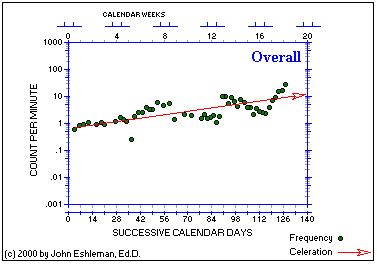
Return to Home Page
Six Celerations

Select a Celeration to View:
* Overall
* Trend following
* Event Following
* Periodic
* Most Recent
* Surprise Free
About the Six Celerations
(From a message posted by John Eshleman on the SC List:)
In one of the more controlled investigations we did with an
earlier version of our (PLS) software, we ran into a situation where
people continued to work on the same module after reaching
a fluency aim. Their celerations flattened out, but it was as
if they were still trying to "eke out" a bit more improvement.
The celerations were not completely flat.
One subject did over 50 timings beyond the point of reaching
fluency. An event-following celeration showed a celeration
between X1.0 and X1.1 after aim was reached. However,
in the final 7 timings, there was a celeration turn-up to
X1.8. That occurred some 42 timings after aim was reached.
The point is, by sticking with the program through thick (the
initial X2.6 celeration leading up to aim) and thin (the
less than X1.1 after aim), the learner did have a late surge
(that X1.8 most-recent celeration).
Another subject, who did 27 timings beyond reaching aim,
had an overall celeration of X1.4 for corrects, and a
most-recent of about /1.1. However, in this subjects'
case, the errors continued to decel after aim, by about
/1.6, except for a late, most-recent celeration turn up
of X100 across the final 3 timings. I chalked that up to
fatigue, since the subjects were doing these timings in
a "massed" practice run, with a timing every couple of
minutes.
The interesting thing about this study, was that it occurred
because of a defect in the computer program. We had the
program set to tell people what their frequency aims were
before they would begin a module. However, there was never
any indication by the program that they'd reached aim, and
no instruction to go on to the next module should they do so.
Those "defects" have since been remedied. However more,
B.F. Skinner, in "A Case History in Scientific Method,"
perhaps his most important testament to the power of
inductive methods, observed that sometimes a breakdown
or defect in experimental apparatus is the very thing that
leads to interesting effects and even discoveries.
In my own personal case of doing SAFMEDS, I always
tried to "eke out" some more improvement after reaching
a fluency aim. The behavior of being fluent at that point
seemed so damn reinforcing, why stop? If I could get
to 50 per minute, why not try for 52 per minute?
We do need to move on to celeration, and like Og says,
not be fluency cultists. So, just getting celerations
reported will be a major start. However, once we do that,
we should think about recording and reporting the "Five"
celeration types:
Plus add a possible sixth: Surprise-Free (a combination of
overall and most-recent).
It turns out, so it would appear, that these celerations have
different functions. An overall celeration does not predict
that one subject's most-recent celeration turn-up (the person
who did 57 timings beyond reaching aim; she'd reached
aim in only 7 timings, for a total of 64 timings!).
Trend-following celerations will pick up rhythms that might
otherwise be missed. Or these will note special circumstances.
That's why long baselines are not necessarily bad: They might
reveal trends and maybe even cycles or rhythms.
Event-following celerations can follow the changes made
to variables independent of the response frequencies. They
may indicate whether an independent variable has an
effect, and by how much.
Periodic celerations are useful -- sometimes -- for administrative
purposes, and maybe for planning purposes and for certain
reporting purposes.
As we move onward, at some point we may want to bring back
the "minimum celeration" -- a computed celeration based on
aim-rate aim-day at the tail end and initial frequencies on the
front end. This celeration can prove useful for certain decision-making
purposes. I have thought about, but not implemented, this idea
into computer-based training. In point of fact, that was one of
my original dissertation ideas -- to have a program that, after
a few timings, computed a minimum celeration, and then used
that as a decision making basis for direct and online changes
to the programmed contingencies. For instance, if behavior
fell below minimum cel for three consecutive timings, have
the system do something to try to put the behavior back on
course. The full set of variables in the operant behavioral
equation would be subject to change in order to do that.
If necessary, have the system present tool skill drills,
teach to errors, or simply issue an alert for an instructor
to intervene.
REFERENCE:
Skinner, B.F. (1956). A case history in scientific method. American Psychologist, 11, 221-233.
For R and D,
-- John Eshleman, Ed.D.
Notices
The chart shown above represents a likeness only of a standard celeration chart. The chart shown above is also a "stylized" chart. That means that I constructed it for teaching and illustrative purposes only. It does not show real data. The frequency dots are larger, proportionately, and the celeration lines range through more chart cycles, than one typically finds.
Dr. Ogden R. Lindsley invented the Standard Celeration Chart, founded Behavior Research Company, and has been the main proponent and developer of both Precision Teaching and standard celeration charting.
Actual Standard Celeration Charts can be purchased from the Behavior Research Company, Box 3351, Kansas City, KS 66103. FAX: 913 362-5900.
12/25/08: Fax orders are no longer accepted at Behavior Research Company. Please order online through the company website.
Page Updated June 6, 2002
Return to Home Page
Copyright 2000 by John W. Eshleman, Ed.D.
widget.hideFooter();
 visitors
visitors
//
Comments (0)
You don't have permission to comment on this page.